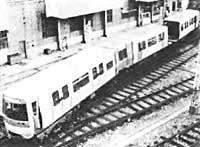New metro in Paris
The sessions of a new metro start in Paris. The new train is called Boa because the curves take them like snakes. Thanks to the new systems applied, the capacity of a six-car train is equal to seven. The new design also eliminates the wheel timbres that occur in closed curves.

Conventional trains have a two-axle bogie at the end of each car. Articulated trains are not new. Two cars share a bogie. Boa's point of differentiation with respect to other articulated trains is to maintain the weight of the wagons on a single axis.
Bogies with two fixed axes work well on most tracks, as the radius of the curves is relatively high. But as the lines of the meters follow the structure of the streets, they have to take very closed curves, of 90º in some cases of the Paris metro. In these curves, apart from the wrecks that annoy the passengers, there is a great wear of the rails.
To address this problem, the eye has a differential on the axes. In the curves the outer impeller has to circulate more than the interior and is the one that produces the timbres and the wear. This obstacle is overcome with the differential.
Greater load capacity is due to new platforms built between cars.





